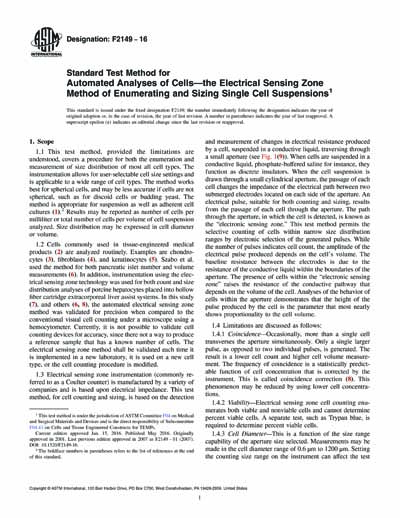Most recent
ASTM F2149-16
Standard Test Method for Automated Analyses of Cells—the Electrical Sensing Zone Method of Enumerating and Sizing Single Cell Suspensions
1.1 This test method, provided the limitations are understood, covers a procedure for both the enumeration and measurement of size distribution of most all cell types. The instrumentation allows for user-selectable cell size settings and is applicable to a wide range of cell types. The method works best for spherical cells, and may be less accurate if cells are not spherical, such as for discoid cells or budding yeast. The method is appropriate for suspension as well as adherent cell cultures (1).2 Results may be reported as number of cells per milliliter or total number of cells per volume of cell suspension analyzed. Size distribution may be expressed in cell diameter or volume.
1.2 Cells commonly used in tissue-engineered medical products (2) are analyzed routinely. Examples are chondrocytes (3), fibroblasts (4), and keratinocytes (5). Szabo et al. used the method for both pancreatic islet number and volume measurements (6). In addition, instrumentation using the electrical sensing zone technology was used for both count and size distribution analyses of porcine hepatocytes placed into hollow fiber cartridge extracorporeal liver assist systems. In this study (7), and others (6, 8), the automated electrical sensing zone method was validated for precision when compared to the conventional visual cell counting under a microscope using a hemocytometer. Currently, it is not possible to validate cell counting devices for accuracy, since there not a way to produce a reference sample that has a known number of cells. The electrical sensing zone method shall be validated each time it is implemented in a new laboratory, it is used on a new cell type, or the cell counting procedure is modified.
1.3 Electrical sensing zone instrumentation (commonly referred to as a Coulter counter) is manufactured by a variety of companies and is based upon electrical impedance. This test method, for cell counting and sizing, is based on the detection and measurement of changes in electrical resistance produced by a cell, suspended in a conductive liquid, traversing through a small aperture (see Fig. 1(9)). When cells are suspended in a conductive liquid, phosphate-buffered saline for instance, they function as discrete insulators. When the cell suspension is drawn through a small cylindrical aperture, the passage of each cell changes the impedance of the electrical path between two submerged electrodes located on each side of the aperture. An electrical pulse, suitable for both counting and sizing, results from the passage of each cell through the aperture. The path through the aperture, in which the cell is detected, is known as the “electronic sensing zone.” This test method permits the selective counting of cells within narrow size distribution ranges by electronic selection of the generated pulses. While the number of pulses indicates cell count, the amplitude of the electrical pulse produced depends on the cell's volume. The baseline resistance between the electrodes is due to the resistance of the conductive liquid within the boundaries of the aperture. The presence of cells within the “electronic sensing zone” raises the resistance of the conductive pathway that depends on the volume of the cell. Analyses of the behavior of cells within the aperture demonstrates that the height of the pulse produced by the cell is the parameter that most nearly shows proportionality to the cell volume.
Content Provider
ASTM International [astm]






